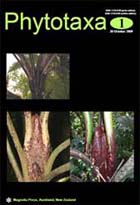Abstract
The presence of short inversions in non-coding plastid DNA is universal and an integral part of its evolution. We studied the effect of these structural changes in phylogenetic inference by measuring phylogenetic accuracy as a topological congruence among topologies inferred from plastid and nuclear sequences in ferns (Lindsaea) and mosses (Brachytheciaceae). We randomly replicated ten subsets of both groups and tested the performance of various coding schemes and phylogenetic methods. Our results demonstrate that short inversions do interfere with phylogenetic analysis, leading into incongruent topologies. The phylogenetic accuracy was increased by removing inversions or applying various coding schemes to them. Parsimony analyses resulted in greater accuracy than maximum likelihood or Bayesian analyses, but this was at least partly explained by slightly poorer resolution of parsimony trees. Due to the great importance of non-coding plastid DNA in species-level plant systematics and the frequency of structural rearrangements in it, we recommend these kinds of data be carefully explored before analysis, and the possible rearrangements to be optimized.

